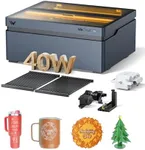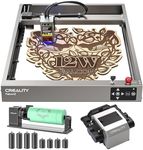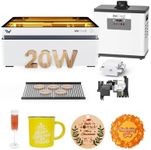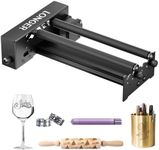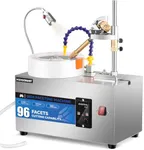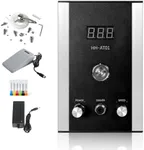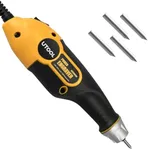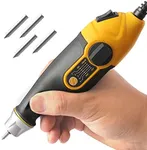Buying Guide for the Best Rotary Engravers
Choosing the right rotary engraver can be a daunting task, but with the right knowledge, you can find the perfect tool for your needs. Rotary engravers are versatile machines used for engraving on various materials such as metal, plastic, wood, and glass. They are commonly used for creating detailed designs, text, and logos. To make an informed decision, you need to understand the key specifications and how they relate to your specific requirements.Engraving AreaThe engraving area refers to the maximum size of the material that the engraver can handle. This is important because it determines the size of the projects you can work on. Engraving areas can range from small (e.g., 4x4 inches) to large (e.g., 24x24 inches or more). If you plan to work on small items like jewelry or nameplates, a smaller engraving area will suffice. However, for larger projects like signs or plaques, you will need a machine with a larger engraving area.
Spindle SpeedSpindle speed is the rate at which the engraving tool rotates, usually measured in revolutions per minute (RPM). This is crucial because it affects the quality and precision of the engraving. Higher spindle speeds (e.g., 20,000 RPM or more) are suitable for fine, detailed work and harder materials, while lower speeds (e.g., 5,000-10,000 RPM) are better for softer materials and less detailed work. Consider the type of material you will be engraving and the level of detail required when choosing the spindle speed.
PowerThe power of a rotary engraver is typically measured in watts. This specification is important because it determines the machine's ability to engrave different materials. Higher power (e.g., 100 watts or more) is needed for harder materials like metal, while lower power (e.g., 20-50 watts) is sufficient for softer materials like plastic or wood. Assess the types of materials you will be working with to determine the appropriate power level for your needs.
Software CompatibilitySoftware compatibility refers to the engraver's ability to work with different design software programs. This is important because it affects how easily you can create and transfer designs to the machine. Some engravers come with proprietary software, while others are compatible with popular design programs like CorelDRAW or Adobe Illustrator. If you already use specific design software, ensure that the engraver you choose is compatible with it. Additionally, consider the ease of use and features of the software provided with the engraver.
Material CompatibilityMaterial compatibility indicates the types of materials the engraver can work with. This is crucial because not all engravers can handle every material. Common materials include metal, plastic, wood, glass, and acrylic. Some engravers are versatile and can work with multiple materials, while others are specialized for specific types. Think about the materials you plan to engrave most frequently and choose a machine that can handle those materials effectively.
Precision and AccuracyPrecision and accuracy refer to the engraver's ability to produce detailed and exact engravings. This is important for achieving high-quality results, especially for intricate designs. Precision is often measured in microns, with lower values indicating higher precision. If your projects require fine details and high accuracy, look for an engraver with high precision. For less detailed work, a machine with standard precision will be sufficient.
Ease of UseEase of use encompasses the user-friendliness of the engraver, including setup, operation, and maintenance. This is important because it affects how quickly you can start using the machine and how efficiently you can complete your projects. Features like intuitive controls, clear instructions, and easy maintenance can make a significant difference. If you are a beginner, look for an engraver with straightforward operation and good customer support. Experienced users might prioritize advanced features and customization options.
